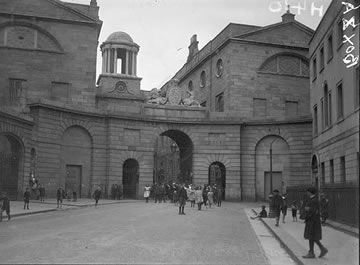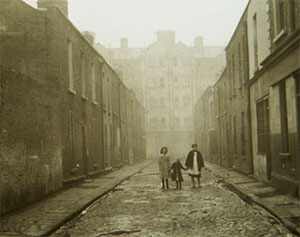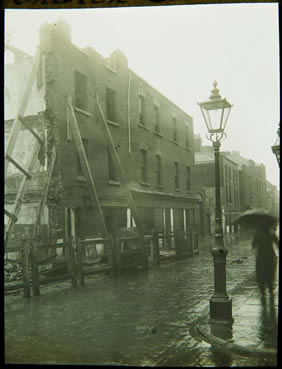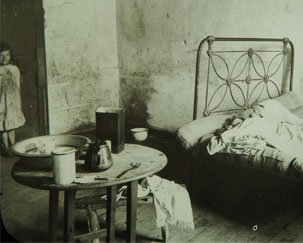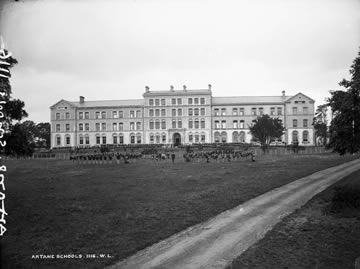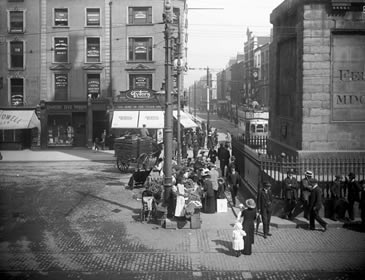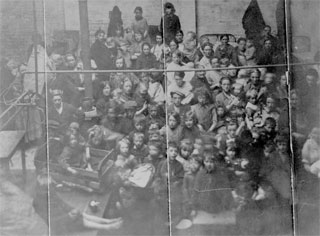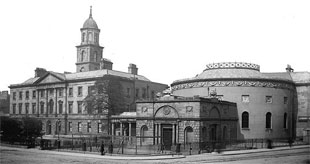Poverty and Health
View the photo galleryIn 1911 Dublin had the worst housing conditions of any city in the United Kingdom. Its extensive slums were not limited to the back-streets or to impoverished ghettos. By 1911 the city slums also incorporated great Georgian houses on previously fashionable streets and squares. As the wealthy moved to the suburbs over the course of the 19th century, their huge, red-brick buildings were abandoned to the rent-paying poor. Tenements in inner-city Dublin were filthy, overcrowded, disease-ridden, teeming with malnourished children and very much at odds with the elite world of colonial and middle-class Dublin.
The decay of Dublin was epitomised by Henrietta Street, which had once been home to generations of lawyers, but was, by 1911, overflowing with poverty. An astonishing 835 people lived in 15 houses. At number 10 Henrietta Street, the Sisters of Charity ran a laundry with more than 50 single women inside. The other houses on the street were filled with families. For example, there were members of nineteen different families living in Number 7. Among the 104 people who shared the house were charwomen, domestic servants, labourers, porters, messengers, painters, carpenters, pensioners, a postman, a tailor, and a whole class of schoolchildren. Out the back were a stable and a piggery.
The story of Henrietta Street was replicated across the city, as streets amalgamated into slums. Life in the slums was raw and desperate. In 1911 nearly 26,000 families lived in inner-city tenements, and 20,000 of these families lived in just one room. Most families were dependent on intermittent casual labour; three out of five workers in the Heney household in Killarney Parade were unemployed. Remarkably, many one-room tenements did not just house a family, but that family also took in members of their extended families or tenants; the Dixon family at Buckingham St. also had a nurse-child, Thomas Power. In 1911 among the tenements of Mabbot Street and Tyrone Street ,17 families kept lodgers, most despite living in a single room.
Death emphasised the precariousness of life for the poor: tenement dwellers died younger, died more often from tuberculosis, died more often in childhood; see very high child mortality (6 survivors from 13 children) in the Dixon household, died even as the buildings they lived in collapsed around them. Dublin Corporation employed men to inspect dangerous buildings, but disasters still took place. Tenements owned by Mrs. Ryan on Church St. for example, collapsed in 1913, killing up to seven people. (See return for Connor family of eight, living in one room in 66 Church st., one of the houses which collapsed). Overall, the death rate in Dublin per thousand was 22.3; in London it was just 15.6.
The death rate in the city was not helped by the unsanitary conditions in inner-city tenements, where livestock were kept in dairy yards, cattle yards (see return for cattleyard worker at Summerhill) and down side-lanes. Drainage was little better than rudimentary and the majority of meat eaten in the city came from beasts slaughtered in small private abattoirs and slaughter-houses like this one on the Phibsboro Rd. Offal and other substances lay on city streets despite being forbidden in a series of acts, such as the Nuisance Acts, through the 19th century.
People living in tenements were failed by Dublin Corporation, the city authority, which did not develop a meaningful policy to improve tenement life. A Housing Inquiry in 1914 found that 16 members of the Corporation owned tenements and it was clear that Corporation members intervened to foil the enforcement of regulations against their properties. The Corporation did attempt a number of successful social housing projects, including one on Benburb Street and Corporation Buildings off the north quays. Other initiatives from the Dublin Artisans’ Dwelling Company and the Iveagh Trust provided greatly improved housing for the working-class, but were necessarily limited in scale.
Tenement dwellers were also failed by the Catholic Church, which had a conservative approach to state relief of poverty, despite the fact that the majority of those who lived in tenements were Catholics. Poverty was the preserve of no creed, of course. Catholics (Ivers family at Summerhill) , Protestants (Glancy family at Grangegorman), Presbyterians (Gentles family at Great Brunswick St.) and Methodists (Percy family at Arran Quay) shared the same streets, the same houses, even the same rooms. Their respective churches were heavily involved in charitable work but it was a feature of Dublin charities that they divided along religious lines and competed with each other, particularly over the welfare of children.
In the city, many families were forced to put their children selling wares on the streets. A 1902 report dealing with the problem of the thousands of children street-selling, noted that in one in six cases, one or both parents were dead. Others were from homes riven with illness, drunkenness or unemployment. Help for some destitute children came from Mrs. Smyly’s Homes and Schools, 11 of which were based in the city. Across the city, the Coombe Ragged School was run for young Protestant boys, and the Dublin Working Boys Home and Harding Technical School operated on Lord Edward Street and was intended for boys working in the city who did not live with their parents.
Under the Children Act, 1908, inspectors known as Infant Protection Visitors were employed. They had much to do. In 1911 there were men and women serving time in Mountjoy Prison for mistreating or for neglecting their children. Many children, themselves, ended up in confinement. There were several penitentiaries for children across the city, including High Park Reformatory for Girls, most of whom were committed for petty theft. And for all manner of reasons, boys could also be sent to prison or to industrial schools such as the one in Artane.
Women tried to make money as dealers selling fish (Mary McCarthy at Gloucester Place), flowers (Frances McQuillan at Coombe Cottages ), old clothes, pigs, fruit (Mary Jane Swords at Little Strand St.) and much more, on the side of the streets. Women worked at home, or with other women, to make various items such as bags, hats, vests and dresses, and worked in laundries and parlours (the Hoey family at Charleville Cottages). Some worked in factories as weavers of wire (Mary Hynes at Kean's Court), and in the fields which still lay in parts of the city. Some were forced to turn to prostitution on the streets or in brothels, and they, too, ended up in Mountjoy Prison.
For those living in poverty, some succour came from the Liberal Government of David Lloyd George and Henry Asquith, arguably the most radical administration to govern Ireland in the twentieth century. Its legacy included the introduction of old age pensions in 1908, labour exchanges in 1909, and a national insurance scheme to afford workers protection against sickness, invalidity and unemployment in 1911. The introduction of the old-age pension for the over-70s was of enormous importance, alleviating some of the distress that attended the last years of those no longer able to work, even if work could be found. The Liberals progressively tackled social issues, sometimes to the discomfort of the Irish parliamentary party, who initially voted against Lloyd George’s famous ‘People’s Budget’ in response to Irish unrest at the additional alcohol duties it imposed.
Further official relief for the poor came through the Poor Law; workhouses, like that at Balrothery , dealt with all manner of social problems from destitution, to old age, illness and abandonment. Workhouses accommodated people who were in need of short-term relief from homelessness, but they also housed those who were permanently destitute. Families were generally separated by gender into different wards on entry and were required to work around the house or the grounds, as was the case at the South Dublin Union workhouse on James’s Street. Workhouses were also the inappropriate homes for many who suffered from long-term mental illness, becoming de facto asylums. More dedicated treatment for mental illness was provided in institutions such as the Central Mental Hospital and the Richmond Asylum.
Charities attempted to fill the gaps left by the state. The Sick and Indigent Roomkeepers Society, founded in Dublin in 1790, offered assistance without religious or moral intent, from its house at 2 Palace Street. Mostly, though, people struggled to survive through their own informal networks, with generations of the same extended family and their in-laws living together in few rooms. The unemployed, the elderly and the infirm, as well as those who had lost spouses or parents, were supported by the able. This was as true for the labourers of the Dublin countryside as it was for those of the city.
Dublin supported many pawn shops, like this one at Buckingham St, offering immediate relief to those in distress. Interest was high, however, and it was not unknown for people to have to pawn essential clothing, boots and work-tools, so worsening the cycle of poverty. Hundreds begged on many of Dublin’s more prosperous streets, including Merrion Row and St. Stephen’s Green. Many were Dubliners, many more had tramped to the city, importing greater distress from rural areas stricken by famine or depression. And many ended up in Mountjoy Prison, imprisoned for begging or for vagrancy. There is even a census return for a man, described as a mendicant , who lived rough in Kingstown.
With nutrition so poor in the city and with so many living in poverty and poor housing, there was great ill-health in Dublin. There was a myriad of small hospitals established in every corner of the city, run by religious orders or charities, and funded by benefactors and philanthropists, with increasing contributions from the state. Protestant hospitals included the Meath, Jervis Street and Dr. Steevens’s. The Mater Hospital was run by the Catholic Sisters of Mercy, while the Rotunda , the Coombe and the South Dublin Lying-in Hospital in Holles Street were designed to improve the appallingly high levels of death in childbirth. Most wealthy and middle-class women stayed at home to have their babies; the lying-in hospitals were intended for those who lived in poverty.
The hospitals were staffed by doctors who graduated from the many medical schools in the city including the Cecilia Street Medical School and the Royal College of Surgeons. A range of nurses’ homes were built across the city, including one off Eccles Street, which opened in 1903. Other caring institutions in the city included the Richmond National Institution for the Industrious Blind and the O’Brien Institute. On the south side of the river, Portobello House, once a hotel, later an asylum for blind women, was, by 1911, a nursing home. And on nearby Camden Row was an early hospice opened in 1904 by Colonel Gascoigne Trench known as the ‘Rest for the Dying’.

